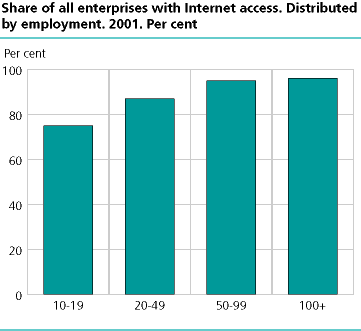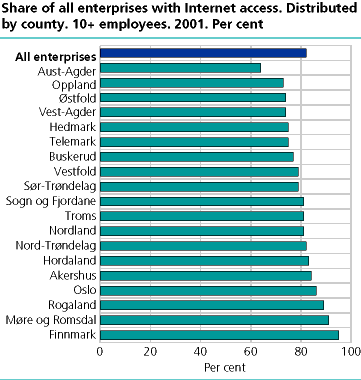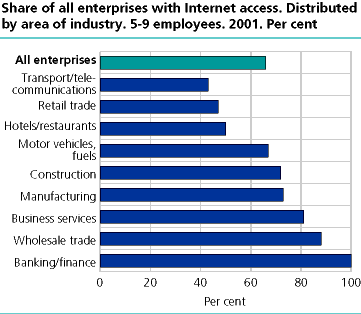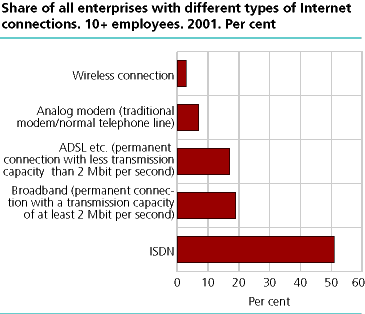Content
Published:
This is an archived release.
Four out of five enterprises have Internet
82 per cent of all enterprises with at least 10 employees had Internet access by the end of 2001. The share increased from 74 per cent in 2000. The Internet is much less common among the smallest enterprises, and retail trade used the Internet least. 2 out of 10 enterprises had broadband.
82 per cent of all Norwegian enterprises with at least 10 employees had Internet access by the end of 2001. The share increased from 74 per cent by the end of 2001. Growth seems to be moderate in 2002 as well. According to the enterprises' plans only three per cent will establish an Internet connection during 2002.
Access to the Internet varies a lot with the size of the enterprises. By the end of 2001 almost all enterprises with at least 100 employees had Internet access. Among enterprises with 10-19 employees the share was 75 per cent.
Highest share in banking and finance
The share with Internet access is highest within banking and finance. In this industry almost all enterprises had access to the Internet by the end of 2001. The share was lowest in retail trade. Only 56 per cent of the enterprises in retail trade had Internet access.
The survey's sample size makes the shares for Internet access uncertain for smaller counties. However, the numbers show that regional differences are levelled out. Internet access is about 80 per cent in most counties. Structures of industry and the enterprises' size distribution vary regionally. Differences between the counties should be evaluated on this background.
Internet access less common among small enterprises
2 out of 3 enterprises with 5-9 employees had Internet access by the end of 2001. Among small enterprises Internet access was most uncommon in transport/telecommunications. In this industry only 43 per cent of all enterprises had access to the Internet. The share was low also in retail trade and the hotel industry with 47 and 50 per cent respectively.
2 out 10 has broadband
Since several enterprises have more than one type of Internet connection, the share for Internet connections exceed the share for Internet access. By the end of 2001 half of all Norwegian enterprises with at least 10 employees had ISDN. It is usual to define broadband as transmission capacity larger than 2 Mbit per second. This survey asked the enterprises if they were connected to the Internet via a "Permanent connection with a transmission capacity of at least 2 Mbit per second". Almost 20 per cent of all Norwegian enterprises with at least 10 employees had broadband by the end of 2001.
The survey also measured Internet usage and electronic commerce. Results from these areas will be published in separate articles. A more detailed presentation of ICT usage in enterprises is coming in the series Reports. The Report will also include calculations of the uncertainty of the most important variables in the survey.
Tables:
- Table 1 Share of all enterprises with Internet access. Distributed by employment groups. 1998-2002. Per cent
- Table 2 Share of all enterprises with Internet access. Distributed by area of industry. 1998-2002. Per cent
- Table 3 Share of all enterprises with Internet access. Distributed by county. 1998-2002. Per cent
- Table 4 Share of all small enterprises (5-9 employees) with Internet access. Distributed by area of industry. 2001-2002. Per cent
- Table 5 Share of all enterprises with different types of Internet connections. Distributed by employment groups. 2001. Per cent
- Table 6 Share of all enterprises with different types of Internet connections. Distributed by area of industry. 2001. Per cent
- Table 7 Share of all enterprises with different types of Internet connections. Distributed by county. 2001. Per cent
- Table 8 Share of all small enterprises (5-9 employees) with different types of Internet connections. Distributed by area of industry. 2001. Per cent
Contact
-
Yun Walther-Zhang
E-mail: yun.walther-zhang@ssb.no
tel.: (+47) 40 90 25 38






